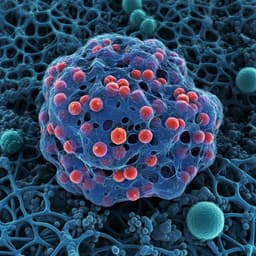
Earth Sciences
Stable isotopes show that earthquakes enhance permeability and release water from mountains
T. Hosono, C. Yamada, et al.
This study reveals fascinating insights into how large crustal earthquakes affect groundwater, showing significant permeability increases and groundwater level rises in response to the 2016 Kumamoto earthquake. Conducted by Takahiro Hosono, Chisato Yamada, Michael Manga, Chi-Yuen Wang, and Masaharu Tanimizu, this research has important implications for understanding hydrological changes in seismically active regions.
Playback language: English
Introduction
The impact of large earthquakes on hydrogeological systems is a significant area of research. Changes in groundwater levels are frequently observed following seismic events, and several mechanisms have been proposed to explain these changes. These include pore-pressure responses to static elastic strain, fluid migration along seismic ruptures, permeability changes from cracking and seismic vibrations, and pore-pressure changes due to liquefaction or consolidation. Stable isotope ratios (δD and δ<sup>18</sup>O) serve as valuable tracers for understanding water provenance and movement. Previous isotopic studies have provided insights, but often lacked the regional context necessary to fully characterize the complex hydrological responses. This study addresses this gap by employing a comprehensive dataset of stable isotope ratios from the Kumamoto region, Japan, to investigate the subsurface hydrogeological responses to the 2016 M<sub>w</sub> 7.0 Kumamoto earthquake. The Kumamoto region's hydrogeology is characterized by permeable volcanic aquifers overlying relatively impermeable basement rocks. Groundwater recharge occurs in the northern and eastern highlands, with flow generally following topographic gradients towards discharge areas like Lake Ezu. Mountain aquifers surrounding the Aso caldera and Kinpo mountains also contribute to the regional flow system. The Kumamoto earthquake sequence involved strike-slip and normal faulting, generating numerous ruptures that intersected existing groundwater flow systems. Prior studies documented coseismic groundwater level fluctuations, including an initial drop followed by a sustained rise in certain areas. This study aimed to determine the origin of the observed water level rise using isotopic fingerprinting, considering potential sources such as soil water infiltration, mixing between aquifers, and increased contributions from mountain aquifers, as well as deep fluids and liquefaction. Understanding these processes is crucial for assessing the broader environmental impacts of earthquakes and for managing water resources in seismically active regions.
Literature Review
Numerous studies have examined coseismic hydrological changes, documenting widespread water level fluctuations after earthquakes. Explanations for these changes typically fall into four categories: (1) pore-pressure responses to elastic strain, (2) fluid migration along seismic ruptures, (3) permeability changes caused by cracking and seismic vibrations, and (4) pore-pressure changes from liquefaction or consolidation. Stable isotopes have been increasingly utilized to trace water movement and identify sources before and after earthquakes. However, these isotopic studies have often been limited by spatial and temporal sampling density, hindering regional-scale interpretations. Previous studies examining coseismic water level rises attributed the phenomenon to permeability enhancement, proposing three possible mechanisms: soil porewater infiltration, inter-aquifer mixing, and increased contributions from surrounding mountains. However, comprehensive isotopic assessments encompassing all these sources have remained scarce, especially regarding the role of deep fluids and liquefaction. This study builds upon this existing research by employing a far larger and more spatially extensive isotopic dataset to elucidate the origin of coseismic water level changes in the Kumamoto region.
Methodology
This study utilized a comprehensive dataset of stable isotope ratios (δD and δ<sup>18</sup>O) from the Kumamoto region to analyze water sources before and after the 2016 Kumamoto earthquake. A total of 1150 water samples were collected and analyzed, representing various sources, including precipitation, soil porewater, river water, springs (both mountain foot and high-elevation), and groundwaters (from both unconfined and confined aquifers). The sampling strategy aimed to cover the entire regional watershed, providing a detailed spatial and temporal overview. Samples were collected before the earthquake (between 2005 and 2014) and after (between 2016 and 2018) to capture changes in water isotopic signatures. Isotopic analyses were performed using continuous-flow gas-ratio mass spectrometry (Delta V Advantage, Thermo Fisher Scientific) and cavity ring-down spectroscopy (Picarro, L2120i and L2130i), ensuring accuracy and cross-validation. Data were compared against the local meteoric water lines defined using monthly precipitation data to assess the origin and evolution of water sources. The researchers used a variety of methods to confirm their results including using samples from different seasons to account for natural variations, checking results against data gathered using a different analytic machine and by different institutions and employing multiple approaches to characterize the hydrogeology and the seismic activity in Kumamoto, using information from various reports on groundwater fluctuations, surface ruptures, and water level changes following the earthquake. The results were then used to infer changes in groundwater flow paths and quantify contributions from different water sources. In addition to this, they referenced previous hydrological models and other work examining hydrochemical and microbial changes following the earthquake.
Key Findings
The isotopic analysis revealed distinct pre-earthquake water compositions. Soil porewaters in recharge areas showed slight evaporation effects compared to the local meteoric water line. Mountain spring waters displayed a strong altitude effect, with high-elevation springs exhibiting more depleted isotopic signatures than mountain foot springs. Groundwater compositions before the earthquake reflected a mixture of soil porewaters, mountain spring waters, and river waters, indicating a contribution from mountain aquifers, which hadn't been documented before this study. Post-earthquake, the most significant isotopic change was observed in groundwaters. The compositional range narrowed, closely resembling the isotopic signature of mountain foot spring waters, regardless of season, aquifer type, or sampling location (except stagnant areas). Mountain spring waters showed slight isotopic depletion after the earthquake, while river waters showed no significant change. Hot spring waters showed a wider range of isotopic compositions, representing various origins, including meteoric waters and mixtures of seawater and deep fluids. The post-seismic isotopic shift in groundwaters indicated a substantial increase in the contribution of mountain aquifer waters, rather than soil porewater, river water, or deep fluids. Isotopic data suggest that waters from the western Aso caldera rim and Mt. Kinpo, particularly from mid-elevation areas, were the primary source of the additional water. This finding is consistent with the observations of increased spring and river discharges, as well as the abnormal rise in groundwater levels after the earthquake. The sustained groundwater level rise in recharge areas is explained by the large volume of released mountain water, while recovery in lateral flow and discharge areas is attributed to flow through preferential pathways. While some localized areas showed increased contributions from soil porewater and deep fluids based on hydrochemical and microbiological analyses, these contributions were negligible in terms of total water volume. The study concludes that the permeability increase triggered by the earthquake facilitated the movement of water from mountain aquifers to down-gradient regional groundwater flow systems.
Discussion
This study's findings directly address the research question regarding the origin of coseismic groundwater level rises. The results strongly support the hypothesis that permeability enhancement in mountain aquifers, caused by the earthquake-induced rupture systems, led to a significant release of water into down-gradient aquifers. The isotopic fingerprinting provides compelling evidence that this released water predominantly originated from mid-elevation mountain aquifers, rather than other potential sources such as soil porewater or deep fluids. The observed changes in groundwater levels, both the initial drop and subsequent rise, are consistent with the formation of new pathways created during the earthquake, through which large volumes of water could be transported. The faster flow observed in recharge and discharge areas after the earthquake implies significant permeability enhancement. The study's regional approach is a key strength, providing a more comprehensive understanding of earthquake impacts on hydrology than prior localized studies. The implications for managing water resources in seismically active regions with volcanic aquifers are substantial.
Conclusion
This research demonstrates that large crustal earthquakes can significantly alter regional hydrological systems, particularly in volcanic regions. The 2016 Kumamoto earthquake resulted in a substantial release of water from mountain aquifers into down-gradient systems due to earthquake-induced permeability enhancement. Isotopic analysis pinpoints mid-elevation mountain aquifers as the primary source of this water. The two-stage coseismic hydrological response consists of an initial groundwater drawdown and subsequent sustained rise and recovery due to water from the mountains. The results highlight the importance of considering seismic activity when assessing water resources and managing water infrastructure in such geologically active areas. Further research should focus on refining models of coseismic hydrological changes, improving our understanding of permeability evolution, and extending the findings to other volcanic arc settings to better assess the global implications of this phenomenon.
Limitations
The study focuses on the Kumamoto region, which might limit the generalizability of the findings to other geological settings. While the study used a large dataset, the sampling might not represent all potential sources or flow pathways equally. The long-term impacts of the permeability changes induced by the earthquake remain to be fully assessed, and future monitoring will be important in observing the ongoing effects. The reliance on stable isotope ratios as primary tracers might not provide complete information regarding all hydrological processes involved. More integrated studies combining isotopic analyses with other geochemical and geophysical data could further enhance understanding.
Related Publications
Explore these studies to deepen your understanding of the subject.







